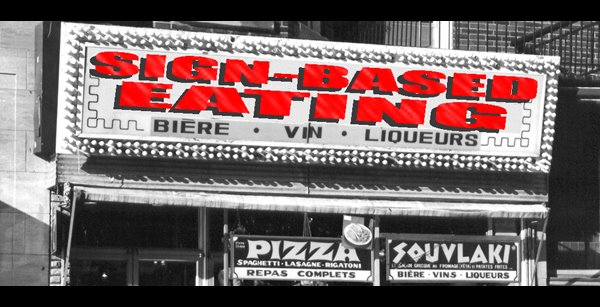
821 Rue Ste-Anne, Yamachiche, QC
Backstory 1: Sign-Based Eating co-writer Dave LeBlanc first tipped us off to the existence of this place, which he had heard about from a co-worker some years ago. Could it be true? Could an Archie Comics-themed snack bar (casse-croûte, in French) actually exist in the small Quebec town of Yamachiche… smack dab in the middle of nowhere between Montreal and Trois-Rivières?
Backstory 2: Exactly how did I end up with a huge box full of Archie Comics Digests stored away in my parents’ basement for years until I reached my mid-twenties? The same way I ended up with piles of Mad magazines and a box of assorted weird stuff from strange publishers like Charlton Comics… Blame it all on the newsstand at the Cavalieri Hilton in Rome!
I spent the summers of 1973 and 1974 in Europe — 4 months of each year, actually — accompanying my father who put in two years working on the launcher for a surveillance drone (the CL-89… look it up) in Italy. That first summer, on the days when I wasn’t out touring the sites with mom, I was stuck in a Rome apartment with nowhere to go and nothing to do as the city took its afternoon siesta. What was a shy, not-fluent-in-Italian, 7 year-old kid to do? The answer: devour any English-language reading material he could get his hands on. The Cavalieri Hilton Hotel, somewhere not too far behind our apartment on one of Rome’s many hills, was the most convenient place for me to get my fix of imported American reading material. Overpriced? Yes, it certainly was. Age-appropriate? I think so, in most cases. Was it stuff I would have picked up if I’d had a wider selection to choose from? Some of it maybe… but I was just so happy to find something — anything — to read that I bought it all!
I devoured so much stuff — from Archie to the Fabulous Furry Freak Brothers — and built up quite a collection… My dad later used a lot of it as packing material when he’d send stuff back to us in Montreal. And so he ended up re-exporting most of this stuff back to North America… where I packed it away in boxes in the basement.
Years later, when I met the woman who would go on to become my better half (named Betty, coincidentally), I discovered that she too had, for some reason, amassed a pile of Archie comics. I think that when I decided to dig out my old collection and give it to Betty for Christmas or her birthday or some other occasion, it clinched the deal between her and me… still going strong today, more than a decade-and-a-half later.
So you see how there was just no way to avoid making our way to the Archie Snack Bar…
“Licensing agreement… we don’t need no licensing agreement”: It’s a little disappointing that the Archie Snack Bar doesn’t go totally overboard in naming menu items after Archie characters and themes. It would have been great, for instance, to have a “Moose Mason Milkshake” or a “Coach Kleats Corn-Dog” but I guess a lot of this stuff doesn’t exactly translate too well into French, the language of choice in Yamachiche. However, the place is plastered with framed prints of various panels from the comic books, and the cooks do wear Archie t-shirts. This is all very surprising, since I seriously doubt that the snack bar holds the rights to use the likenesses of any of the characters in the Archie universe. Yamachiche is an out of the way place and is probably under the Archie Comics radar. But I’ll bet if we were talking about a certain big-eared, falsetto-voiced mouse, old Walt’s surveillance drones would surely home in on this joint and slap it with a cease and desist order faster than you can say “Hot Dog.”
The sign: Actually, there are two — one for the Archie Snack Bar and, facing it, across the parking lot, another for the Veronica Mini Golf Course next door.
Thought about 1: The things we do for love.
Thought about 2: There’s a little Forsythe “Jughead” Jones in all of us.
Video bonus: For a video featuring a few brief scenes shot at the Archie Snack Bar, go HERE.














